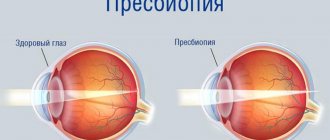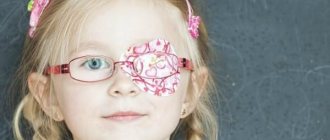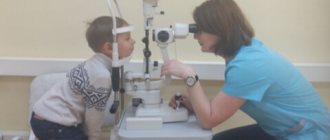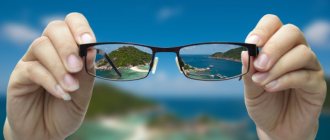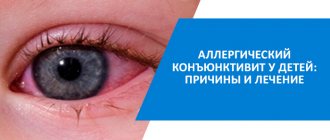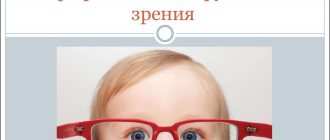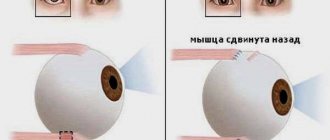Causes of visual impairment in children
There are many reasons for visual impairment in preschool children, but the primary role is given to physiological eye fatigue and impaired accommodation. A rich curriculum in kindergarten and school, educational games and watching cartoons on the computer - all this contributes to the development of myopia.
But a child’s busy schedule only creates the preconditions, and the true enemies of good vision are:
- bad light;
- incorrect selection of furniture for classes;
- heredity;
- deficiency of vitamins and minerals in the diet;
- lack of work and rest schedule.
Some diseases can also play a role - acute respiratory viral infections, diabetes mellitus and others.
Therefore, preventing vision loss in children comes down to organizing a workspace and rest regime, monitoring the diet and enriching it with vitamins and minerals. In addition, schoolchildren need to visit an ophthalmologist at least once a year, and if symptoms of myopia are detected, every six months.
Other causes of loss and decrease in vision in a teenager
If you look at the statistics, vision loss in teenagers is not such a rare occurrence. Moreover, teenagers are very active and strive to prove their independence to the world, due to which they live a more active life and are very susceptible to criticism. A teenager can temporarily lose his sight even for psychological reasons. Deterioration of vision can happen because a teenager is embarrassed to wear glasses. At the same time, they are embarrassed to tell their parents or, due to some confrontations, cannot. As a result, vision is irretrievably lost and a person enters adult life with a good “minus” or “plus” in diopters.
Another reason is uncontrolled sports and injuries. Teenagers with weak and especially failing eyesight should not exert themselves too much. But in pursuit of a beautiful figure, children do not particularly listen to mom and dad. Therefore, parents should not only instruct the child, but also try to become his friend, so that the child does not take advice with hostility.
Prevention
Lighting, body position in space while reading and working with small details, the distance from the eyes to the book are factors that are extremely important for children.
- The desk and chair must correspond to the height of the child. The distance between the eyes and the lying book should be 30-35 centimeters.
- When reading, drawing and writing, it is important to provide moderately bright lighting falling on the table from the left (for right-handed people).
- Children get tired faster than adults. Therefore, the interval of their activities should alternate in accordance with age: for children 2-5 years old, the optimal working period is 15-20 minutes, followed by 10 minutes of active play or warm-up. First-graders are required to work for 35 minutes with a 15-minute break, and only at the age of 9-10 does the workload increase to an academic hour.
- Similar time frames are established for studying on the computer, watching cartoons and types of creativity associated with small work.
For children with visual impairments, during 15-minute breaks it will be useful to use exercises that train the eye muscles. An ophthalmologist at the Optic Center clinic will help you choose the ideal complex, but you can always use effective and simple techniques:
- Alternating between looking into the distance and looking at objects up close. In many schoolchildren, myopia is caused by impaired accommodation of the eye, and this exercise can help in the fight to maintain visual acuity.
- We close our eyes and then open them wide. This workout will improve blood circulation and relax the eye muscles.
- Drawing pictures in the air. Ask the child to follow your hand with his eyes and draw geometric shapes with it, maintaining the maximum amplitude. Exercise improves accommodation and helps counteract progressive myopia.
Particular attention should be paid to the nutrition of children of preschool and primary school age, especially if the child’s distance vision has become worse. The causes of myopia often lie in a deficiency of vitamins A and B, folic acid, and minerals - selenium, zinc, manganese. Therefore, it is important to include whole grains, green vegetables and fruits, and leafy crops in your diet. Don’t forget about the “medicines” you know from childhood – carrots and blueberries.
After distance learning, schoolchildren's vision decreases: is it possible to restore eye sharpness?
After forced self-isolation, schoolchildren's vision deteriorated.
Photo: Mikhail FROLOV
The school year has begun and many parents have noticed that it was not possible to arrive without losses. As soon as the students sat down at their desks, it became obvious that the vision of many of them had deteriorated significantly. And quarantine played almost the main role in this regard. How the period of self-isolation and distance learning affected the development of children’s vision, we asked Igor Aznauryan, pediatric ophthalmic surgeon, doctor of medical sciences, professor, founder of the association of children’s eye clinics “Yasny Vzor” :
“The fact that the period of self-isolation did not pass without a trace for the health of children’s eyes is an obvious fact. The number of eye pathologies increased after this period. This is due, first of all, to the fact that children’s eyes also “grow” and go through a stage of development. Any stay outside the physiological conditions for them can lead to visual impairment. And the quarantine period was one of those. And in this case, we can identify several leading factors that caused the deterioration of the health of children's eyes.
1. Locked within four walls, unable to see the horizon.
Our eyes were created by nature in order to look into the distance. For them, this is the most physiological state - calm study of distant objects. Looking at and viewing an object at close range is a labor-intensive task for the eyes. And in this case they spend some effort. The children's visual system has not yet been formed, and if it is regularly overloaded, this will certainly affect its normal development. So being constantly in an apartment cannot be called physiological for the formation of a child’s vision.
The lack of sunlight had a negative impact on the gases.
Photo: Mikhail FROLOV
2. We lived without the sun, with artificial light.
Another important fact is that ultraviolet rays also affect the normal development of the eyes. If children spend most of their time outdoors during daylight hours, this contributes to the normal formation of the visual system and prevents vision deterioration due to myopia. For example, those children who spend 12 hours a week on the street experience myopia 10 times less often than those who spend only 3 hours a week.
3. Excessive passion for gadgets.
Let us immediately note that there are no studies that would prove the influence of gadgets on children’s vision. In order to carry them out, the purity of the experiment must be observed. That is, find a group of children who would not use phones and computers at all. These people live in areas with minimal civilization. These are, for example, Africa and Central Asia. But here it is necessary to take into account their genetics and lifestyle in general - all this affects the development of children's vision. So this is in theory, but in practice such an experiment will have little evidence.
On the other hand, it is obvious that gadgets cause overstrain of the visual system. Any phone, tablet or computer is a constant source of light. For example, reading text from a sheet of paper is much more physiological for vision. In this case, the light first falls on the book, then is reflected and hits the eyes. Whereas reading from a screen is more tiring for them.
The fact that few people use gadgets correctly also causes a lot of stress. Mostly, children play or read from the screen lying down, without observing the recommended distance of 35-40 cm from the screen.
Gadgets cause overstrain of the visual system.
Photo: Yulia PYKHALOVA
TO THE POINT
The longer you use a gadget, the more your head hurts
Long-term games on a computer or phone provoke so-called asthenopic complaints, which are associated with a violation of accommodation (the ability of the eye to focus at different distances). Focusing on nearby objects for long periods of time can cause headaches, eye strain, and decreased vision. Accommodation is disrupted much faster with regular and long-term use of VR glasses (virtual reality glasses). In this case, the same myopia may develop at an accelerated rate.
BY THE WAY
What visual pathologies have worsened?
Of course, as Igor Aznauryan says, this is myopia. And the modern lifestyle in every possible way contributes to the development of this disease. But in this case, it should be noted that all children are different and the visual system of each child has its own characteristics. At the time of quarantine, some already had myopia, some, on the contrary, had farsightedness, and some of the children suffered from astigmatism. Depending on the existing features, certain visual impairments appeared after self-isolation.
Can they be corrected? In some cases, yes, it is possible to restore eye function with conservative treatment. But it happens that the process has already started and you can only pause it. In this case, treatment will be aimed at slowing down the developing disease and conducting preventive courses to avoid further deterioration of vision.
It is necessary to limit the time children use gadgets with small screens.
Photo: Mikhail FROLOV
IMPORTANT
How to save and restore your child's eyes
Taking gadgets away from a teenager is a utopian measure. They have already become a part of our lives. But it’s worth following certain rules when performing short-distance exercises. Recommendations from Professor Igor Aznauryan:
1. Follow the regime for using gadgets. Every 20-30 minutes you need to switch your vision to studying distant objects. Let him be distracted and look out the window into the distance. The duration of such a break should be at least 5 minutes.
2. Use virtual reality glasses for no more than 15 minutes a day. Do not give this gadget to children at high risk of developing myopia or with existing myopia.
3. Reduce the time spent on gadgets with small screens. If it is possible to transfer visual load from the smartphone screen to the computer screen, be sure to do so.
4. Give preference to paper media. If possible, have all the material that your child needs to learn from the screen in printed form.
Give preference to paper media.
Photo: Maria LENZ
5. Use special glasses for working on a computer. Their lenses have a special filter that dampens the blue spectrum of the screen. This allows you to reduce visual strain. In the case when a child is prescribed any kind of spectacle correction, when choosing modern high-quality lenses for glasses, parents can be absolutely calm, because these filters are already included in them.
6. Walk more often! Look at the clouds, trees, leaves. This will be the best exercise for the eyes and the prevention of possible diseases. And don’t forget about adequate physical activity. Any sport - cycling, light jogging, swimming - has a good effect not only on general well-being, but also on vision.
BY THE WAY
Caught in the net: 74 percent of teenagers cannot do without a smartphone or computer
Children's dependence on gadgets is growing, and knowledge of the basics of computer security lags far behind (details)
Symptoms of visual impairment
A school-age child may himself complain that he cannot see well from the board. Annual clinical examination also contributes to the rapid detection of pathology. It is much more difficult to recognize pathology in preschool children who cannot themselves report the problem. The following behavior patterns should be alarming symptoms for parents:
- the baby blinks frequently and constantly rubs his eyes;
- the child has difficulty seeing into the distance, squinting when looking out the window or looking at some object;
- quickly gets tired of drawing, modeling, and loses interest.
In children under one year of age, myopia is signaled by divergent strabismus.
If you notice these symptoms, you should immediately consult a doctor.
Causes of poor vision in a child
There may be several reasons for visual impairment. Among them, we highlight 3 main ones:
- Heredity. If both parents are diagnosed with myopia, then there is a chance that the child will also develop the disease. The degree of myopia will not necessarily be the same in parents and children. If, for example, a mother has a low degree of myopia, then the child may develop a high degree of myopia due to excessive load on the visual apparatus. The earlier in age myopia or farsightedness occurs, the greater its degree is possible subsequently. The risk of passing on the disease by inheritance is high, and this also applies to the tendency to develop it;
- Congenital myopia. A common occurrence in premature babies, caused by weakness and high extensibility of the sclera;
- Acquired myopia. It is most often diagnosed between 9 and 12 years of . The reasons for this phenomenon: excessively rapid growth of the child, including elongation of the eyeball; intense loads (a lot of homework, reading, mental work, watching TV for many hours, playing on a smartphone beyond measure and without breaks); deficiency of minerals and vitamins.
Advertisement
Examination of young patients and diagnostics
The examination plan for preschool children and primary school students includes:
- survey and clarification of complaints;
- autorefractometry or skiascopy using an ophthalmoscope, determination of refraction;
- examination of the fundus after drug dilation of the pupil;
- determining the nature of movement using a four-point color test;
- determination of the volume of movement of the eyeballs;
- determination of the angle of strabismus;
- measuring intraocular pressure;
- biomicroscopy (examination of the anterior segment of the eye using a slit lamp);
- recommendations and prescription of treatment.
If a child’s vision deterioration is detected, glasses are selected as early as possible. And parents have nothing to fear: all modern children's models are made of plastic, which will not become a source of sharp fragments in the event of children's fights. An alternative to glasses for children over 6 years old can be “night correction” - orthokeratology. Its essence lies in the use of special lenses only at night, which correct the shape of the cornea and restore vision for the entire next day.
In schoolchildren, myopia is often temporary and is caused by disturbances in eye accommodation. Therefore, the ophthalmologist often schedules two visits a week apart and prescribes drops. In case of temporary impairments, repeated testing will not reveal any deterioration in distance vision.
Alarming symptoms
If a child (usually at the age of 7-9 years, when the visual load increases) has complaints of a headache, difficulty focusing, or a blurred image before the eyes, then he probably has vision problems. If, in addition, the child is slouched, has difficulty learning, and handwriting leaves much to be desired, do not delay in visiting an ophthalmologist for diagnosis. Perhaps your son or daughter needs vision correction, hardware treatment and further observation by an ophthalmologist.
What other symptoms should parents be wary of? The child may squint, frequently rub his eyes, tilt his head low to examine an object at a closer distance, be afraid to look at the light, get tired quickly while reading, and periodically suffer from lacrimation. If your baby, preschooler or teenager is moving closer and closer to the TV while watching cartoons, do not hesitate to visit an ophthalmologist.
Diagnosis of myopia: what to do?
There are no radical methods for treating myopia in children. Laser correction is only permissible from 18 years of age. Therefore, glasses become the main method of combating vision loss. Their constant wearing relieves children's eyes from increased stress and helps stabilize the process.
In addition to glasses, children are prescribed physical therapy - electrophoresis with dibazole, magnetic therapy, electrical stimulation and a number of other methods. The child’s diet is enriched with vitamins - folic and nicotinic acid, calcium supplements.
Nowadays, there are a number of ways to correct and stabilize vision in children. Doctors at the Optic Center clinic will help you choose effective and reliable options.
A child’s vision is falling – reasons
There are three main factors that cause eye problems in children:
- Genetic predisposition. If close relatives suffered from abnormalities in the functioning of the visual apparatus, there is a high risk that the pathology will be passed on to the children;
- Impact of negative external factors. Reading books while lying down or in a moving vehicle, spending a long time at the computer, increased eye strain;
- Psychology. If a child has suffered severe emotional shock, he may begin to lose his sight. Most often this applies to children who are still mentally unstable and are easily exposed to external influences. If a baby witnesses a cruel scene, it will be etched in his memory for a long time. In the future, he subconsciously tries to protect himself and not see such things. As a result, eye sharpness decreases.
